Light Stabilized Polyolefin Films, Tapes And Monofilaments
MUELLER; Daniel ; et al.
U.S. patent application number 16/830347 was filed with the patent office on 2020-07-16 for light stabilized polyolefin films, tapes and monofilaments. This patent application is currently assigned to BASF SE. The applicant listed for this patent is BASF SE. Invention is credited to Daniel MUELLER, Tania WEYLAND.
| Application Number | 20200223996 16/830347 |
| Document ID | / |
| Family ID | 52477738 |
| Filed Date | 2020-07-16 |



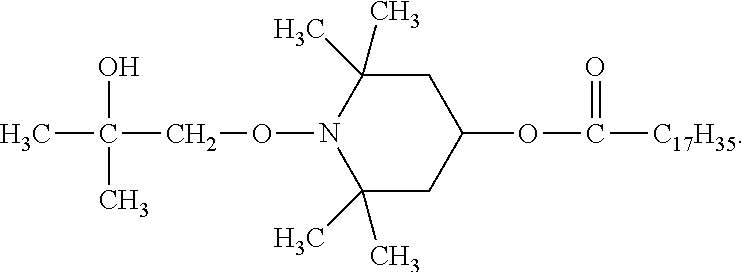



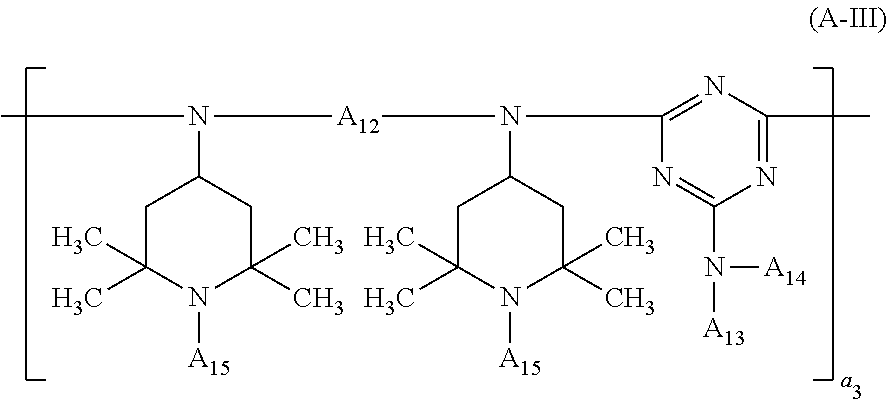
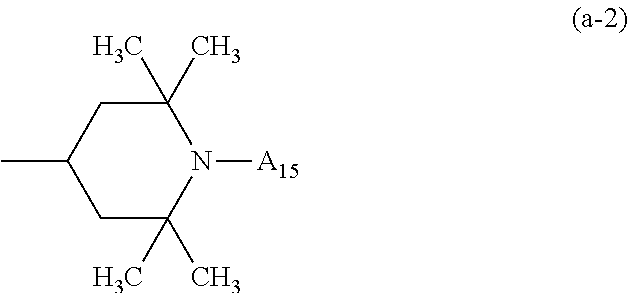



View All Diagrams
| United States Patent Application | 20200223996 |
| Kind Code | A1 |
| MUELLER; Daniel ; et al. | July 16, 2020 |
LIGHT STABILIZED POLYOLEFIN FILMS, TAPES AND MONOFILAMENTS
Abstract
A process for reducing water carry-over of a light stabilized polyolefin film, tape or filament which contains component (A) as light stabilizer and which is passed through a water bath during production, characterized in that the polyolefin film, tape or monofilament additionally comprises component (B) as light stabilizer, an example of component (A) is ##STR00001## wherein E.sub.1 is ##STR00002## E.sub.2 is ##STR00003## and a.sub.3 is a number from 2 to 10, and an example of component (B) is ##STR00004##
| Inventors: | MUELLER; Daniel; (Basel, CH) ; WEYLAND; Tania; (Widensolen, FR) | ||||||||||
| Applicant: |
|
||||||||||
|---|---|---|---|---|---|---|---|---|---|---|---|
| Assignee: | BASF SE Ludwigshafen DE |
||||||||||
| Family ID: | 52477738 | ||||||||||
| Appl. No.: | 16/830347 | ||||||||||
| Filed: | March 26, 2020 |
Related U.S. Patent Documents
| Application Number | Filing Date | Patent Number | ||
|---|---|---|---|---|
| 15551943 | Aug 18, 2017 | |||
| PCT/EP2016/053206 | Feb 16, 2016 | |||
| 16830347 | ||||
| Current U.S. Class: | 1/1 |
| Current CPC Class: | B29K 2023/12 20130101; B29K 2023/06 20130101; B29C 48/08 20190201; B29C 48/919 20190201; C08K 2201/014 20130101; C08K 5/34 20130101; C08J 2323/12 20130101; C08J 2323/06 20130101; C08J 5/18 20130101; D01F 1/10 20130101; C08K 5/34 20130101; C08L 23/02 20130101 |
| International Class: | C08J 5/18 20060101 C08J005/18; D01F 1/10 20060101 D01F001/10; B29C 48/08 20060101 B29C048/08; B29C 48/88 20060101 B29C048/88; C08K 5/34 20060101 C08K005/34 |
Foreign Application Data
| Date | Code | Application Number |
|---|---|---|
| Feb 20, 2015 | EP | 15155952.3 |
Claims
1-13. (canceled)
14. A mixture, comprising: a compound of formula (A-I-1): ##STR00063## wherein a.sub.1 is a number from 2 to 10; a compound of formula (A-III-2): ##STR00064## wherein a.sub.3 is a number from 2 to 10; and a compound of formula (B-I-1) or a compound of formula (B-II-1): ##STR00065## wherein b.sub.1 is a number from 1 to 10.
15. The mixture according to claim 14, comprising the compound of formula (A-I-1), the compound of formula (A-III-2), and the compound of formula (B-I-1).
16. The mixture according to claim 14, comprising the compound of formula (A-I-1), the compound of formula (A-III-2), and the compound of formula (B-II-1).
Description
[0001] The present invention relates to a process for the reduction of water carry-over of a light stabilized polyolefin film, tape or monofilament which is passed through a water bath during production, to the polyolefin film, tape or monofilament made in accordance to that process and to the use of specific light stabilizers to reduce the water carry-over of a light stabilized polyolefin film, tape or monofilament.
[0002] A widespread method for producing polyolefin films, tapes or monofilaments consists in extruding the polymer melt through a suitable apparatus and, in the form of a film, tape or monofilament, into a water bath, where the film, tape or monofilament is cooled and solidified. The film, tape or monofilament may then in turn be passed out of the water bath and subjected to further steps of processing. On emerging from the water bath the film, tape or monofilament can entrain water, which interferes with subsequent steps of processing. This effect, the entrainment of water from the water bath, is often termed "water carry-over" in the technical literature, and this can be abbreviated to WCO.
[0003] Stretching of the film at a suitable temperature results in orientation and further crystallization of the polymer, resulting in the specific properties. This second step of processing may take place directly on the film, but the primary film is often split into tapes prior to the stretching process. Since the desired properties are obtained during the stretching process, precise adherence to all process parameters is essential here. Even traces of moisture on the film or on the tapes prior to the stretching process alter the subsequent stretching and orientation so as to produce very severe variations in the quality of the product obtained. The effects of this go beyond merely the corresponding major variations in the quality of the resultant final product. Even during production or processing, the poor quality can cause break-offs of the tapes, for example, and thus stop production. A source of water which can lead to the problems mentioned is the cooling bath into which the primary film is extruded. Although most plastics, in particular the polyolefins, such as polyethylene (PE) or polypropylene (PP) are very hydrophobic and therefore have little tendency to absorb water, it is frequently found that at relatively high production speeds water droplets or a thin film of water adhere to the film when this is drawn over the water bath. In addition, various additives such as light stabilizers have to be added to the polymer to ensure that the final product has good functionality. Some of these additives contribute to increased entrainment of water from the water bath. The additives, and also a maximum processing speed, are essential if suitable products are to be produced at low cost. A reduction in processing speed leads to uneconomic production. The addition of necessary additives, some of which lead to a worsening of WCO (i.e. more WCO and therefore poorer product) is also impossible to avoid, because otherwise the product properties brought about by the additives cannot be achieved.
[0004] The reduction of WCO is currently promoted via simple design measures during machinery manufacture. For example, the draw-off of the film from the water bath is usually vertically upward, so that gravity alone maximizes the amount of water dropping away. In addition, use is often made of squeeze rollers and/or air knives to remove the maximum amount of water from the film. There are other technical methods, depending on the specific configuration of the machine.
[0005] There continues to be a requirement for a process for improving WCO during the production of polyolefin films, tapes and monofilaments. Ideally, no undesirable side-effects should arise, and the process should also be capable of problem-free use for existing formulations.
[0006] Surprisingly, it has now been found that the addition of a specific second sterically hindered amine light stabilizer to a light stabilized polyolefin film, tape or monofilament which contain already a sterically hindered amine light stabilizer can markedly reduce WCO during the production. This is unexpected particularly because the two sterically hindered amines belong to the same class of compounds. It was completely surprising and in no way predictable that particular combinations of two sterically hindered amine light stabilizers show a synergistic improvement in WCO properties.
[0007] The invention therefore provides a process for reducing water carry-over of a light stabilized polyolefin film (preferably monolayer), tape (preferably monolayer) or monofilament which contains component (A) as light stabilizer and which is passed through a water bath during production, characterized in that the polyolefin film, tape or monofilament additionally comprises component (B) as light stabilizer, component (A) is at least one compound selected from the group consisting of compounds of the formula (A-I), compounds of the formula (A-II) and compounds of the formula (A-III),
##STR00005##
wherein A.sub.1 is hydrogen or C.sub.1-C.sub.4alkyl, A.sub.2 is a direct bond or C.sub.1-C.sub.10alkylene, and a.sub.1 is a number from 2 to 20;
##STR00006##
wherein A.sub.3, A.sub.4 and A.sub.5 independently of one another are C.sub.2-C.sub.18alkylene, A.sub.6, A.sub.7, A.sub.8, A.sub.9 and A.sub.10 independently of one another are hydrogen, C.sub.1-C.sub.12alkyl, C.sub.5-C.sub.12cycloalkyl or a group of the formula (a-1),
##STR00007##
the radicals A.sub.11 independently of one another are hydrogen, C.sub.1-C.sub.12alkyl or C.sub.5-C.sub.12cycloalkyl, and a.sub.2 is a number from 1 to 20;
##STR00008##
wherein A.sub.12 is C.sub.2-C.sub.18alkylene, C.sub.5-C.sub.7cycloalkylene or C.sub.1-C.sub.4alkylenedi(C.sub.5-C.sub.7cycloalkylene), A.sub.13 and A.sub.14 independently of one another are hydrogen, C.sub.1-C.sub.12alkyl, C.sub.5-C.sub.12cycloalkyl or a group of the formula (a-2),
##STR00009##
or the radicals A.sub.13 and A.sub.14, together with the nitrogen atom to which they are bonded, form a 5- to 10-membered heterocyclic ring, the radicals A.sub.15 independently of one another are hydrogen, C.sub.1-C.sub.12alkyl or C.sub.5-C.sub.12cycloalkyl, and a.sub.3 is a number from 2 to 20; component (B) is at least one compound selected from the group consisting of compounds of the formula (B-I), compounds of the formula (B-II), compounds of the formula (B-III) and compounds of the formula (B-IV),
##STR00010##
wherein R.sub.1 is C.sub.1-C.sub.18alkyl, C.sub.1-C.sub.18hydroxyalkyl, cyclohexyl or hydroxycyclohexyl or R.sub.1 is a group --C(C.sub.6H.sub.5)(H)CH.sub.2--OH and R.sub.2 is C.sub.1-C.sub.25alkyl or a group of the formula (b-1);
##STR00011##
wherein x is an integer from 2 to 8 and y is zero or 1;
##STR00012##
wherein R.sub.3 is C.sub.2-C.sub.18alkylene, C.sub.5-C.sub.7cycloalkylene or C.sub.1-C.sub.4alkylenedi(C.sub.5-C.sub.7cycloalkylene), the radicals R.sub.4 independently of one another are C.sub.1-C.sub.12alkyl or C.sub.5-C.sub.12cycloalkyl, R.sub.5 and R.sub.6 independently of one another are hydrogen, C.sub.1-C.sub.12alkyl, C.sub.5-C.sub.12cycloalkyl or a group of the formula (b-2),
##STR00013##
or the radicals R.sub.5 and R.sub.6, together with the nitrogen atom to which they are bonded, form a 5- to 10-membered heterocyclic ring and b.sub.1 is a number from 1 to 20;
##STR00014##
wherein the radicals R.sub.8, R.sub.9 and R.sub.10 independently of one another are C.sub.2-C.sub.18alkylene and the radicals R.sub.7 independently of one another are a group of the formula (b-3)
##STR00015##
wherein R.sub.11 and R.sub.12 independently of one another are hydrogen, C.sub.1-C.sub.12alkyl, C.sub.5-C.sub.12cycloalkyl or a group of the formula (b-4)
##STR00016##
and the radicals R.sub.13 independently of one another are C.sub.1-C.sub.12alkyl or C.sub.5-C.sub.12cycloalkyl;
##STR00017##
wherein R.sub.5 is C.sub.1-C.sub.25alkyl, n is a number from 1 to 10, and W is a wax residue comprising between 50 and 1000 carbon atoms, preferably a residue of a polyethylene or polypropylene wax.
[0008] Components (A) and (B) are preferably in one layer, if the film is a multilayer film.
[0009] The compounds of components (A) and (B) are known and largely commercially available and can be prepared according to known methods.
[0010] The compounds of component (A) can be prepared for example in analogy to the methods described in U.S. Pat. Nos. 4,233,412, 4,477,615 (CAS 136,504-96-6) and U.S. Pat. Nos. 4,108,829, 4,086,204, 4,331,586, 6,046,304 and 6,297,299.
[0011] The compounds of component (B) can be prepared for example in analogy to the methods described in U.S. Pat. Nos. 6,388,072, 6,117,995, 6,420,462 and 6,677,451, and 5,844,026.
[0012] Preferred compounds of component (A) are the commercial products Tinuvin.RTM. 622, Sabostab.RTM. UV 119, Uvasorb.RTM. HA88, Uvasorb.RTM. HA10, Chimassorb.RTM. 944, Chimassorb.RTM. 2020, Cyasorb.RTM. UV 3346, Cyasorb.RTM. UV 3529 and Dastib.RTM. 1082.
[0013] Preferred compounds of component (B) are the commercial products Tinuvin.RTM. NOR 371, Tinuvin.RTM. 123, ADK STAB.RTM. LA81 or Flamestab.RTM. NOR 116.
[0014] The polyolefin is preferably a polyethylene or a polypropylene and contains for example 0.01 to 10%, in particular 0.1 to 1%, relative to the weight of the polyolefin, of the sum of components (A) and (B).
[0015] The weight ratio of component (A) to component (B) is for example 1:20 to 20:1, preferably 1:15 to 15:1.
[0016] The meanings of the terminal groups which saturate the free valences in the compounds of the formulae (A-I), (A-II), (A-III) and (B-II) depend on the processes used for their preparation. The terminal groups can also be modified after the preparation of the compounds.
[0017] If the compounds of the formula (A-I) are prepared, for example, by reacting a compound of the formula
##STR00018##
in which A.sub.1 is hydrogen or methyl, with a dicarboxylic acid diester of the formula Y.sub.0--OOC-A.sub.2-COO--Y.sub.0, in which Y.sub.0 is, for example, methyl, ethyl or propyl, and A.sub.2 is as defined above, the terminal group bonded to the 2,2,6,6-tetramethyl-4-oxypiperidin-1-yl radical is hydrogen or --CO-A.sub.2-COO--Y.sub.0, and the terminal group bonded to the diacyl radical is --O--Y.sub.0 or
##STR00019##
[0018] In the compounds of the formula (A-II) the terminal groups bonded to the triazine radical is, for example, Cl or a group
##STR00020##
and the terminal group bonded to the amino radical is, for example, hydrogen or a group
##STR00021##
[0019] If the compounds of the formula (A-III) are prepared by reacting a compound of the formula
##STR00022##
in which X.sub.0 is, for example, halogen, in particular chlorine, and A.sub.13 and A.sub.14 are as defined above, with a compound of the formula
##STR00023##
in which A.sub.12 and A.sub.15 are as defined above, the terminal group bonded to the diamino radical is for example hydrogen or
##STR00024##
and the terminal group bonded to the triazine radical is for example X.sub.0 or
##STR00025##
[0020] If X.sub.0 is halogen, it is advantageous to replace this, for example, by --OH or an amino group when the reaction is complete. Examples of amino groups which may be mentioned are pyrrolidin-1-yl, morpholino, --NH.sub.2, --N(C.sub.1-C.sub.8)alkyl).sub.2 and --NR.sub.0(C.sub.1-C.sub.8alkyl), in which R.sub.0 is hydrogen or a group of the formula (a-2).
[0021] One of the particularly preferred compounds of the formula (A-III) is
##STR00026##
wherein E.sub.1 is
##STR00027##
E.sub.2 is
##STR00028##
[0022] and a.sub.3 is a number from 2 to 10.
[0023] The preparation of this compound is described in Example 10 of U.S. Pat. No. 6,046,304.
[0024] In the compounds of the formula (B-II), the end group bonded to the diamino radical is for example hydrogen or
##STR00029##
and the terminal group bonded to the triazine radical is for example
##STR00030##
[0025] Examples of alkyl having up to 25 carbon atoms are methyl, ethyl, propyl, isopropyl, n-butyl, sec-butyl, isobutyl, tert-butyl, 2-ethylbutyl, n-pentyl, isopentyl, 1-methyl pentyl, 1,3-dimethyl butyl, n-hexyl, 1-methyl hexyl, n-heptyl, isoheptyl, 1,1,3,3-tetra methyl butyl, 1-methyl heptyl, 3-methyl heptyl, n-octyl, 2-ethyl- hexyl, 1,1,3-tri methyl-hexyl, 1,1,3,3-tetra- methyl pentyl, nonyl, decyl, undecyl, 1-methyl undecyl, dodecyl, 1,1,3,3,5,5-hexa methyl hexyl, tridecyl, tetradecyl, pentadecyl, hexadecyl, heptadecyl and octadecyl.
[0026] Examples of C.sub.5-C.sub.12cycloalkyl are cyclopentyl, cyclohexyl, cycloheptyl, cyclooctyl and cyclododecyl. Cyclohexyl is preferred.
[0027] Examples of alkylene having up to 18 carbon atoms are methylene, ethylene, propylene, trimethylene, tetramethylene, pentamethylene, 2,2-dimethyltrimethylene, hexamethylene, decamethylenen and octadecamethylene.
[0028] A preferred example of C.sub.5-C.sub.7cycloalkylene is cyclohexylene.
[0029] A preferred example of C.sub.1-C.sub.4alkylenedi(C.sub.5-C.sub.7cycloalkylene) is cyclohexylene-methylene-cyclohexylene.
[0030] A preferred example of a 5-to 7-membered heterocyclic ring is a morpholine group.
[0031] In a preferred process A.sub.1 is hydrogen,
A.sub.2 is C.sub.2-C.sub.6alkylene, and a.sub.1 is a number from 2 to 10; A.sub.3, A.sub.4 and A.sub.5 independently of one another are C.sub.2-C.sub.5alkylene, A.sub.6, A.sub.7, A.sub.8, A.sub.9 and A.sub.10 independently of one another are C.sub.1-C.sub.4alkyl, the radicals A.sub.11 independently of one another are hydrogen or C.sub.1-C.sub.4alkyl, and a.sub.2 is a number from 1 to 10; A.sub.12 is C.sub.2-C.sub.6alkylene, A.sub.13 and A.sub.14 independently of one another are hydrogen, C.sub.1-C.sub.4alkyl, cyclohexyl or a group of the formula (a-2), or the radicals A.sub.13 and A.sub.14, together with the nitrogen atom to which they are bonded, form a morpholino group, the radicals A.sub.15 independently of one another are hydrogen or C.sub.1-C.sub.4alkyl, and a.sub.3 is a number from 2 to 10, R.sub.1 is C.sub.1-C.sub.11alkyl or C.sub.2-C.sub.6hydroxyalkyl, R.sub.2 is C.sub.10-C.sub.20alkyl or a group of the formula (b-1); R.sub.3 is C.sub.2-C.sub.6alkylene, the radicals R.sub.4 independently of one another are C.sub.1-C.sub.4alkyl or cyclohexyl; R.sub.5 and R.sub.6 independently of one another are hydrogen, C.sub.1-C.sub.4alkyl, cyclohexyl or a group of the formula (b-2), or the radicals R.sub.5 and R.sub.6, together with the nitrogen atom to which they are bonded, form a morpholino group and b.sub.1 is a number from 1 to 10; R.sub.8, R.sub.9 and R.sub.10 independently of one another are C.sub.2-C.sub.6alkylene and the radicals R.sub.7 independently of one another are a group of the formula (b-3), R.sub.11 and R.sub.12 independently of one another are C.sub.1-C.sub.4alkyl, and the radicals R.sub.13 independently of one another are C.sub.1-C.sub.4alkyl or cyclohexyl.
[0032] According to a preferred embodiment the compound of the formula (A-I) corresponds to the formula (A-I-1)
##STR00031##
wherein a.sub.1 is a number from 2 to 10, the compound of the formula (A-II) corresponds to the formula (A-II-1) or (A-II-2),
##STR00032##
wherein a.sub.2 is a number from 1 to 10,
##STR00033##
wherein a.sub.2 is a number from 1 to 10, the compound of the formula (A-III) corresponds to the formula (A-III-1), (A-III-2), (A-III-3) or (A-III-4),
##STR00034##
wherein a.sub.3 is a number from 2 to 10,
##STR00035##
wherein a.sub.3 is a number from 2 to 10,
##STR00036##
wherein A.sub.15 is hydrogen or methyl and a.sub.3 is a number from 2 to 10,
##STR00037##
wherein a.sub.3 is a number from 2 to 10. the compound of the formula (B-I) corresponds to the formula (B-I-1), (B-I-2) or (B-I-3),
##STR00038##
the compound of the formula (B-II) corresponds to the formula (B-II-1),
##STR00039##
wherein b.sub.1 is a number from 1 to 10, the compound of the formula (B-III) corresponds to the formula (B-III-1),
##STR00040##
wherein R.sub.7 is a group of the formula (b-3-1).
##STR00041##
[0033] According to a particular preferred embodiment component (A) is a compound of the formula (A-I-1) and component (B) is a compound of the formula (B-II-1), or
component (A) is a compound of the formula (A-II-1-a) and component (B) is a compound of the formula (B-III-1), or component (A) is a compound of the formula (A-III-2) and component (B) is a compound of the formula (B-I-1),
##STR00042##
wherein a.sub.1 is a number from 2 to 10,
##STR00043##
wherein X is the group
##STR00044##
and Y is the group
##STR00045##
##STR00046##
wherein a.sub.3 is a number from 2 to 10,
##STR00047##
wherein b.sub.1 is a number from 1 to 10,
##STR00048##
wherein R.sub.7 is a group of the formula (b-3-1).
##STR00049##
[0034] The polyolefin may additionally contain one or more conventional additives. Suitable examples are listed below.
[0035] 1. Antioxidants
[0036] 1.1. Alkylated monophenols, for example 2,6-di-tert-butyl-4-methylphenol, 2-tert-butyl-4,6-dimethyl phenol, 2,6-di-tert-butyl-4-ethylphenol, 2,6-di-tert-butyl-4-n-butylphenol, 2,6-di-tert-butyl-4-isobutylphenol, 2,6-dicyclopentyl-4-methylphenol, 2-(.alpha.-methylcyclohexyl)-4,6-dimethylphenol, 2,6-dioctadecyl-4-methylphenol, 2,4,6-tricyclohexylphenol, 2,6-di-tert-butyl-4-methoxymethylphenol, nonylphenols which are linear or branched in the side chains, for example, 2,6-di-nonyl-4-methylphenol, 2,4-dimethyl-6-(1'-methylundec-1'-yl)phenol, 2,4-dimethyl-6-(1'-methylheptadec-1'-yl)phenol, 2,4-dimethyl-6-(1'-methyltridec-1'-yl)phenol and mixtures thereof.
[0037] 1.2. Alkylthiomethylphenols, for example 2,4-dioctylthiomethyl-6-tert-butylphenol, 2,4-dioctylthiomethyl-6-methylphenol, 2,4-dioctylthiomethyl-6-ethylphenol, 2,6-didodecylthiomethyl-4-nonylphenol.
[0038] 1.3. Hydroquinones and alkylated hydroquinones, for example 2,6-di-tert-butyl-4-methoxyphenol, 2,5-di-tert-butylhydroquinone, 2,5-di-tert-amylhydroquinone, 2,6-diphenyl-4-octadecyloxyphenol, 2,6-di-tert-butylhydroquinone, 2,5-di-tert-butyl-4-hydroxyanisole, 3,5-di-tert-butyl-4-hydroxyanisole, 3,5-di-tert-butyl-4-hydroxyphenyl stearate, bis(3,5-di-tert-butyl-4-hydroxyphenyl) adipate.
[0039] 1.4. Tocopherols, for example .alpha.-tocopherol, .beta.-tocopherol, .gamma.-tocopherol, .delta.-tocopherol and mixtures thereof (vitamin E).
[0040] 1.5. Hydroxylated thiodiphenyl ethers, for example 2,2'-thiobis(6-tert-butyl-4-methylphenol), 2,2'-thiobis(4-octylphenol), 4,4'-thiobis(6-tert-butyl-3-methylphenol), 4,4'-thiobis(6-tert-butyl-2-methylphenol), 4,4'-thiobis(3,6-di-sec-amylphenol), 4,4'-bis(2,6-dimethyl-4-hydroxyphenyl)disulfide.
[0041] 1.6. Alkylidenebisphenols, for example 2,2'-methylenebis(6-tert-butyl-4-methylphenol), 2,2'-methylenebis(6-tert-butyl-4-ethylphenol), 2,2'-methylenebis[4-methyl-6-(.alpha.-methylcyclohexyl)phenol], 2,2'-methylenebis(4-methyl-6-cyclohexylphenol), 2,2'-methylenebis(6-nonyl-4-methylphenol), 2,2'-methylenebis(4,6-di-tert-butylphenol), 2,2'-ethylidenebis(4,6-di-tert-butylphenol), 2,2'-ethylidenebis(6-tert-butyl-4-isobutylphenol), 2,2'-methylenebis[6-(.alpha.-methylbenzyl)-4-nonylphenol], 2,2'-methylenebis[6-(.alpha.,.alpha.-dimethylbenzyl)-4-nonylphenol], 4,4'-methylenebis(2,6-di-tert-butylphenol), 4,4'-methylenebis(6-tert-butyl-2-methyl phenol), 1,1-bis(5-tert-butyl-4-hydroxy-2-methylphenyl)butane, 2,6-bis(3-tert-butyl-5-methyl-2-hydroxybenzyl)-4-methylphenol, 1,1,3-tris(5-tert-butyl-4-hydroxy-2-methylphenyl)butane, 1,1-bis(5-tert-butyl-4-hydroxy-2-methyl-phenyl)-3-n-dodecylmercaptobutane- , ethylene glycol bis[3,3-bis(3'-tert-butyl4'-hydroxyphenyl)butyrate], bis(3-tert-butyl-4-hydroxy-5-methyl-phenyl)dicyclopentadiene, bis[2-(3'-tert-butyl-2'-hydroxy-5'-methyl benzyl)-6-tert-butyl-4-methylphenyl]terephthalate, 1,1-bis-(3,5-dimethyl-2-hydroxyphenyl)butane, 2,2-bis(3,5-di-tert-butyl-4-hydroxyphenyl)propane, 2,2-bis(5-tert-butyl-4-hydroxy2-methylphenyl)-4-n-dodecylmercaptobutane, 1,1,5,5-tetra-(5-tert-butyl-4-hydroxy-2-methylphenyl)pentane.
[0042] 1.7. O-, N- and S-benzyl compounds, for example 3,5,3',5'-tetra-tert-butyl-4,4'-dihydroxydibenzyl ether, octadecyl-4-hydroxy-3,5-dimethylbenzylmercaptoacetate, tridecyl-4-hydroxy-3,5-di-tert-butyl benzyl mercaptoacetate, tris(3,5-di-tert-butyl-4-hydroxybenzyl)amine, bis(4-tert-butyl-3-hydroxy-2,6-dimethylbenzyl)dithioterephthalate, bis(3,5-di-tert-butyl-4-hydroxybenzyl)sulfide, isooctyl-3,5-di-tert-butyl-4-hydroxybenzylmercaptoacetate.
[0043] 1.8. Hydroxybenzylated malonates, for example dioctadecyl-2,2-bis(3,5-di-tert-butyl-2-hydroxybenzyl)malonate, di-octadecyl-2-(3-tert-butyl-4-hydroxy-5-methylbenzyl)malonate, di-dodecylmercaptoethyl-2,2-bis (3,5-di-tert-butyl-4-hydroxybenzyl)malonate, bis[4-(1,1,3,3-tetramethylbutyl)phenyl]-2,2-bis(3,5-di-tertbutyl-4-hydrox- ybenzyl)malonate.
[0044] 1.9. Aromatic hydroxybenzyl compounds, for example 1,3,5-tris(3,5-di-tert-butyl-4-hydroxybenzyl)-2,4,6-trimethylbenzene, 1,4-bis(3,5-di-tert-butyl-4-hydroxybenzyl)-2,3,5,6-tetramethylbenzene, 2,4,6-tris(3,5-di-tert-butyl-4-hydroxybenzyl)phenol.
[0045] 1.10. Triazine compounds, for example 2,4-bis(octylmercapto)-6-(3,5-di-tert-butyl-4-hydroxyanilino)-1,3,5-triaz- ine, 2-octylmercapto-4,6-bis(3,5-di-tert-butyl-4-hydroxyanilino)-1,3,5-tri- azine, 2-octylmercapto-4,6-bis(3,5-di-tert-butyl-4-hydroxyphenoxy)-1,3,5-t- riazine, 2,4,6-tris(3,5-di-tert-butyl-4-hydroxyphenoxy)-1,2,3-triazine, 1,3,5-tris(3,5-di-tert-butyl-4-hydroxybenzyl)isocyanurate, 1,3,5-tris(4-tert-butyl3-hydroxy-2,6-dimethylbenzyl)isocyanurate, 2,4,6-tris(3,5-di-tert-butyl-4-hydroxyphenylethyl)-1,3,5-triazine, 1,3,5-tris(3,5-di-tert-butyl-4-hydroxyphenylpropionyl)-hexahydro-1,3,5-tr- iazine, 1,3,5-tris(3,5-dicyclohexyl-4-hydroxybenzyl)isocyanurate.
[0046] 1.11. Benzylphosphonates, for example dimethyl-2,5-di-tert-butyl-4-hydroxybenzylphosphonate, diethyl-3,5-di-tert-butyl-4-hydroxybenzylphosphonate, dioctadecyl-3,5-di-tert-butyl-4-hydroxybenzylphosphonate, dioctadecyl-5-tert-butyl-4-hydroxy-3-methylbenzylphosphonate, the calcium salt of the monoethyl ester of 3,5-ditert-butyl-4-hydroxybenzylphosphonic acid.
[0047] 1.12. Acylaminophenols, for example 4-hydroxylauranilide, 4-hydroxystearanilide, octyl N-(3,5-di-tert-butyl-4-hydroxyphenyl)carbamate.
[0048] 1.13. Esters of .beta.-(3,5-di-tert-butyl-4-hydroxyphenyl)propionic acid with mono- or polyhydric alcohols, e.g. with methanol, ethanol, n-octanol, i-octanol, octadecanol, 1,6-hexanediol, 1,9-nonanediol, ethylene glycol, 1,2-propanediol, neopentyl glycol, thiodiethylene glycol, diethylene glycol, triethylene glycol, pentaerythritol, tris(hydroxyethyl)isocyanurate, N,N'-bis(hydroxyethyl)oxamide, 3-thiaundecanol, 3-thiapentadecanol, trimethylhexanediol, trimethylolpropane, 4-hydroxymethyl-1-phospha-2,6,7-trioxabicyclo[2.2.2]octane.
[0049] 1.14. Esters of .beta.-(5-tert-butyl-4-hydroxy-3-methylphenyl)propionic acid with mono- or polyhydric alcohols, e.g. with methanol, ethanol, n-octanol, i-octanol, octadecanol, 1,6-hexanediol, 1,9-nonanediol, ethylene glycol, 1,2-propanediol, neopentyl glycol, thiodiethylene glycol, diethylene glycol, triethylene glycol, pentaerythritol, tris(hydroxyethyl)isocyanurate, N,N'-bis(hydroxyethyl)oxamide, 3-thiaundecanol, 3-thiapentadecanol, trimethylhexanediol, trimethylolpropane, 4-hydroxymethyl-1-phospha-2,6,7-trioxabicyclo[2.2.2]octane; 3,9-bis[2-{3-(3-tert-butyl-4-hydroxy-5-methylphenyl)propionyloxy}-1,1-dim- ethylethyl]-2,4,8,10-tetraoxaspiro[5.5]undecane.
[0050] 1.15. Esters of .beta.-(3,5-dicyclohexyl-4-hydroxyphenyl)propionic acid with mono- or polyhydric alcohols, e.g. with methanol, ethanol, octanol, octadecanol, 1,6-hexanediol, 1,9-nonanediol, ethylene glycol, 1,2-propanediol, neopentyl glycol, thiodiethylene glycol, diethylene glycol, triethylene glycol, pentaerythritol, tris(hydroxyethyl)isocyanurate, N,N'-bis(hydroxyethyl)oxamide, 3-thiaundecanol, 3-thiapentadecanol, trimethylhexanediol, trimethylolpropane, 4-hydroxymethyl-1-phospha-2,6,7-trioxabicyclo[2.2.2]octane.
[0051] 1.16. Esters of 3,5-di-tert-butyl-4-hydroxyphenyl acetic acid with mono- or polyhydric alcohols, e.g. with methanol, ethanol, octanol, octadecanol, 1,6-hexanediol, 1,9-nonanediol, ethylene glycol, 1,2-propanediol, neopentyl glycol, thiodiethylene glycol, diethylene glycol, triethylene glycol, pentaerythritol, tris(hydroxyethyl)isocyanurate, N,N'-bis(hydroxyethyl)oxamide, 3-thiaundecanol, 3-thiapentadecanol, trimethylhexanediol, trimethylolpropane, 4-hydroxymethyl-1-phospha-2,6,7-trioxabicyclo[2.2.2]octane.
[0052] 1.17. Amides of .beta.-(3,5-di-tert-butyl-4-hydroxyphenyl)propionic acid e.g. N,N'-bis(3,5-ditert-butyl-4-hydroxyphenylpropionyl)hexamethylen- ediamide, N,N'-bis(3,5-di-tert-butyl-4-hydroxyphenylpropionyl)trimethylene- diamide, N,N'-bis(3,5-di-tert-butyl-4-hydroxyphenylpropionyl)hydrazide, N,N'-bis[2-(3-[3,5-di-tert-butyl-4-hydroxyphenyl]propionyloxy)ethyl]oxami- de (Naugard XL-1, supplied by Uniroyal).
[0053] 1.18. Ascorbic acid (vitamin C)
[0054] 1.19. Aminic antioxidants, for example N,N'-di-isopropyl-p-phenylenediamine, N,N'-disec-butyl-p-phenylenediamine, N,N'-bis(1,4-dimethylpentyl)-p-phenylenediamine, N,N'-bis(1-ethyl-3-methylpentyl)-p-phenylenediamine, N,N'-bis(1-methylheptyl)-p-phenylenediamine, N,N'-dicyclohexyl-p-phenylenediamine, N,N'-diphenyl-pphenylenediamine, N,N'-bis(2-naphthyl)-p-phenylenediamine, N-isopropyl-N'-phenyl-pphenylenediamine, N-(1,3-dimethylbutyl)-N'-phenyl-p-phenylenediamine, N-(1-methylheptyl)-N'-phenyl-p-phenylenediamine, N-cyclohexyl-N'-phenyl-pphenylenediamine, 4-(p-toluenesulfamoyl)diphenylamine, N,N'-dimethyl-N,N'-di-secbutyl-p-phenylenediamine, diphenylamine, N-allyldiphenylamine, 4-isopropoxydiphenylamine, N-phenyl-1-naphthylamine, N-(4-tert-octylphenyl)-1-naphthylamine, N-phenyl-2-naphthylamine, octylated diphenylamine, for example p,p'-di-tert-octyldiphenylamine, 4-n-butylaminophenol, 4-butyrylaminophenol, 4-nonanoylaminophenol, 4-dodecanoylaminophenol, 4-octadecanoylaminophenol, bis(4-methoxyphenyl)amine, 2,6-di-tert-butyl-4-dimethylaminomethylphenol, 2,4'-diaminodiphenylmethane, 4,4'-diaminodiphenylmethane, N,N,N',N'-tetramethyl-4,4'-diaminodiphenylmethane, 1,2-bis[(2-methylphenyl)amino]ethane, 1,2-bis(phenylamino)propane, (o-tolyl)biguanide, bis[4-(1',3'-dimethylbutyl)phenyl]amine, tert-octylated N-phenyl-1-naphthylamine, a mixture of mono- and dialkylated tert-butyl/tert-octyldiphenylamines, a mixture of mono- and dialkylated nonyldiphenylamines, a mixture of mono- and dialkylated dodecyldiphenylamines, a mixture of mono- and dialkylated isopropyl/isohexyldiphenylamines, a mixture of mono- and dialkylated tert-butyldiphenylamines, 2,3-dihydro-3,3-dimethyl-4H-1,4-benzothiazine, phenothiazine, a mixture of mono- and dialkylated tert-butyl/tertoctylphenothiazines, a mixture of mono- and dialkylated tert-octyl-phenothiazines, N-allylphenothiazine, N,N,N',N'-tetraphenyl-1,4-diaminobut-2-ene.
[0055] 2. UV Absorbers and Light Stabilizers
[0056] 2.1. 2-(2'-Hydroxyphenyl)benzotriazoles, for example 2-(2'-hydroxy-5'-methylphenyl)benzotriazole, 2-(3',5'-di-tert-butyl-2'-hydroxyphenyl)benzotriazole, 2-(5'-tert-butyl-2'-hydroxyphenyl)benzotriazole, 2-(2'-hydroxy-5'-(1,1,3,3-tetramethyl butyl)phenyl)benzotriazole, 2-(3',5'-di-tert-butyl-2'-hydroxyphenyl)-5-chlorobenzotriazole, 2-(3'-tert-butyl-2'-hydroxy-5'-methylphenyl)-5-chloro-benzotriazole, 2-(3'-sec-butyl-5'-tert-butyl-2'-hydroxyphenyl)benzotriazole, 2-(2'-hydroxy-4'-octyloxyphenyl)benzotriazole, 2-(3',5'-di-tert-amyl-2'-hydroxyphenyl)benzotriazole, 2-(3',5'-bis-(.alpha.,.alpha.-dimethylbenzyl)-2'-hydroxyphenyl)benzotriaz- ole, 2-(3'-tert-butyl-2'-hydroxy-5'-(2-octyloxycarbonylethyl)phenyl)-5-chl- oro-benzotriazole, 2-(3'-tert-butyl-5'-[2-(2-ethylhexyloxy)-carbonylethyl]-2'-hydroxyphenyl)- -5-chloro-benzotriazole, 2-(3'-tertbutyl-2'-hydroxy-5'-(2-methoxycarbonylethyl)phenyl)-5-chloro-be- nzotriazole, 2-(3'-tertbutyl-2'-hydroxy-5'-(2-methoxycarbonylethyl)phenyl)benzotriazol- e, 2-(3'-tert-butyl-2'-hydroxy-5'-(2-octyloxycarbonylethyl)phenyl)benzotri- azole, 2-(3'-tert-butyl-5'-[2-(2-ethylhexyloxy)carbonylethyl]-2'-hydroxyph- enyl)benzotriazole, 2-(3'-dodecyl-2'-hydroxy5'-methylphenyl)benzotriazole, 2-(3'-tert-butyl-2'-hydroxy-5'-(2-isooctyloxycarbonylethyl)phenyl benzotriazole, 2,2'-methylene-bis[4-(1,1,3,3-tetramethylbutyl)-6-benzotriazole-2-ylpheno- l]; the transesterification product of 2-[3'-tert-butyl-5'-(2-methoxycarbonylethyl)-2'-hydroxyphenyl]-2H-benzotr- iazole with polyethylene glycol 300; [R--CH.sub.2CHCOO--CH.sub.2CH.sub.2 .sub.2, where R=3'-tert-butyl-4'-hydroxy-5'-2H-benzotriazol-2-ylphenyl, 242'-hydroxy-3'-(.alpha.,.alpha.-dimethylbenzyl)-5'-(1,1,3,3-tetramethylb- utyl)-phenyl]benzotriazole; 2-[2'-hydroxy-3'-(1,1,3,3-tetramethylbutyl)-5'-(.alpha.,.alpha.-dimethylb- enzyl)-phenyl]benzotriazole.
[0057] 2.2. 2-Hydroxybenzophenones, for example the 4-hydroxy, 4-methoxy, 4-octyloxy, 4-decyloxy, 4-dodecyloxy, 4-benzyloxy, 4,2',4'-trihydroxy and 2'-hydroxy-4,4'-dimethoxy derivatives.
[0058] 2.3. Esters of substituted and unsubstituted benzoic acids, for example 4-tert-butylphenyl salicylate, phenyl salicylate, octylphenyl salicylate, dibenzoyl resorcinol, bis(4-tert-butylbenzoyl)resorcinol, benzoyl resorcinol, 2,4-di-tert-butyl phenyl 3,5-di-tert-butyl-4-hydroxybenzoate, hexadecyl 3,5-di-tert-butyl-4-hydroxybenzoate, octadecyl 3,5-ditert-butyl-4-hydroxybenzoate, 2-methyl-4,6-di-tert-butyl phenyl 3,5-di-tert-butyl-4-hydroxybenzoate.
[0059] 2.4. Acrylates, for example ethyl .alpha.-cyano-.beta.,.beta.-diphenylacrylate, isooctyl .alpha.-cyano-.beta.,.beta.-diphenylacrylate, methyl .alpha.-carbomethoxycinnamate, methyl .alpha.-cyano-.beta.-methyl-p-methoxycinnamate, butyl .alpha.-cyano-.beta.-methyl-p-methoxy-cinnamate, methyl .alpha.-carbomethoxy-p-methoxycinnamate, N-(.beta.-carbomethoxy-.beta.-cyanovinyl)-2-methylindoline, neopentyl tetra(.alpha.-cyano-.beta.,.beta.-diphenylacrylate.
[0060] 2.5. Nickel compounds, for example nickel complexes of 2,2'-thio-bis[4-(1,1,3,3-tetramethylbutyl)phenol], such as the 1:1 or 1:2 complex, with or without additional ligands such as n-butylamine, triethanolamine or N-cyclohexyldiethanolamine, nickel dibutyldithiocarbamate, nickel salts of the monoalkyl esters, e.g. the methyl or ethyl ester, of 4-hydroxy-3,5-di-tert-butylbenzylphosphonic acid, nickel complexes of ketoximes, e.g. of 2-hydroxy-4-methylphenylundecylketoxime, nickel complexes of 1-phenyl-4-lauroyl-5-hydroxypyrazole, with or without additional ligands.
[0061] 2.6. Sterically hindered amines, for example carbonic acid bis(1-undecyloxy-2,2,6,6-tetramethyl-4-piperidyl)ester, bis(2,2,6,6-tetramethyl-4-piperidyl)sebacate, bis(2,2,6,6-tetramethyl-4-piperidyl)succinate, bis(1,2,2,6,6-pentamethyl-4-piperidyl)sebacate, bis(1-octyloxy-2,2,6,6-tetramethyl-4-piperidyl)sebacate, bis(1,2,2,6,6-pentamethyl-4-piperidyl) n-butyl-3,5-di-tert-butyl-4-hydroxybenzylmalonate, the condensate of 1-(2-hydroxyethyl)-2,2,6,6-tetramethyl-4-hydroxypiperidine and succinic acid, linear or cyclic condensates of N,N'-bis(2,2,6,6-tetramethyl-4-piperidyl)hexamethylenediamine and 4-tert-octylamino-2,6-dichloro-1,3,5-triazine, tris(2,2,6,6-tetramethyl-4-piperidyl)nitrilotriacetate, tetrakis(2,2,6,6-tetramethyl-4-piperidyl)-1,2,3,4-butanetetracarboxylate, 1,1'-(1,2-ethanediyl)-bis(3,3,5,5-tetramethylpiperazinone), 4-benzoyl-2,2,6,6-tetramethyl piperidine, 4-stearyloxy-2,2,6,6-tetramethyl piperidine, bis(1,2,2,6,6-pentamethylpiperidyl)-2-n-butyl-2-(2-hydroxy-3,5-di-tert-bu- tylbenzyl)malonate, 3-n-octyl-7,7,9,9-tetramethyl-1,3,8-triazaspiro[4.5]decane-2,4-dione, bis(1-octyloxy-2,2,6,6-tetramethylpiperidyl)sebacate, bis(1-octyloxy-2,2,6,6-tetramethylpiperidyl)succinate, linear or cyclic condensates of N,N'-bis(2,2,6,6-tetramethyl-4-piperidyl)hexamethylenediamine and 4-morpholino-2,6-dichloro-1,3,5-triazine, the condensate of 2-chloro-4,6-bis(4-n-butylamino-2,2,6,6-tetramethylpiperidyl)-1,3,5-triaz- ine and 1,2-bis(3-aminopropylamino)ethane, the condensate of 2-chloro-4,6-di-(4-n-butylamino-1,2,2,6,6-pentamethylpiperidyl)-1,3,5-tri- azine and 1,2-bis(3-aminopropylamino)ethane, 8-acetyl-3-dodecyl-7,7,9,9-tetramethyl-1,3,8-triazaspiro[4.5]decane-2,4-d- ione, 3-dodecyl-1-(2,2,6,6-tetramethyl-4-piperidyl)pyrrolidine-2,5-dione, 3-dodecyl-1-(1,2,2,6,6-pentamethyl-4-piperidyl)pyrrolidine-2,5-dione, a mixture of 4-hexadecyloxy- and 4-stearyloxy-2,2,6,6-tetramethylpiperidine, a condensate of N,N'-bis(2,2,6,6-tetramethyl-4-piperidyl)hexamethylenediamine and 4-cyclohexylamino-2,6-dichloro-1,3,5-triazine, a condensate of 1,2-bis(3-aminopropylamino)ethane and 2,4,6-trichloro-1,3,5-triazine as well as 4-butylamino-2,2,6,6-tetramethylpiperidine (CAS Reg. No. [136504-96-6]); a condensate of 1,6-hexanediamine and 2,4,6-trichloro-1,3,5-triazine as well as N,N-dibutylamine and 4-butylamino-2,2,6,6-tetramethylpiperidine (CAS Reg. No. [192268-64-7]); N-(2,2,6,6-tetramethyl-4-piperidyl)-n-dodecylsuccinimide, N-(1,2,2,6,6-pentamethyl-4-piperidyl)-n-dodecylsuccinimide, 2-undecyl-7,7,9,9-tetramethyl-1-oxa-3,8-diaza-4-oxo-spiro[4,5]decane, a reaction product of 7,7,9,9-tetramethyl-2-cycloundecyl-1-oxa-3,8-diaza-4-oxospiro-[4,5]decane and epichlorohydrin, 1,1-bis(1,2,2,6,6-pentamethyl-4-piperidyloxycarbonyl)-2-(4-methoxyphenyl)- ethene, N,N'-bis-formyl-N,N'-bis(2,2,6,6-tetramethyl-4-piperidyl)hexamethy- lenediamine, a diester of 4-methoxymethylenemalonic acid with 1,2,2,6,6-pentamethyl-4-hydroxypiperidine, poly[methylpropyl-3-oxy-4-(2,2,6,6-tetramethyl-4-piperidyl)]siloxane, a reaction product of maleic acid anhydride-.alpha.-olefin copolymer with 2,2,6,6-tetramethyl-4-aminopiperidine or 1,2,2,6,6-pentamethyl-4-aminopiperidine, 2,4-bis[N-(1-cyclohexyloxy-2,2,6,6-tetramethylpiperidine-4-yl)-N-butylami- no]-6-(2-hydroxyethyl)amino-1,3,5-triazine, 1-(2-hydroxy-2-methylpropoxy)-4-octadecanoyloxy-2,2,6,6-tetramethylpiperi- dine, 5-(2-ethylhexanoyl)oxymethyl-3,3,5-trimethyl-2-morpholinone, Sanduvor (Clariant; CAS Reg. No. 106917-31-1], 5-(2-ethylhexanoyl)oxymethyl-3,3,5-trimethyl-2-morpholinone, the reaction product of 2,4-bis[(1-cyclohexyloxy-2,2,6,6-piperidine-4-yl)butylamino]-6-chloro-s-t- riazine with N,N'-bis(3-aminopropyl)ethylenediamine), 1,3,5-tris(N-cyclohexyl-N-(2,2,6,6-tetramethylpiperazine-3-one-4-yl)amino- )-s-triazine, 1,3,5-tris(N-cyclohexylN-(1,2,2,6,6-pentamethylpiperazine-3-one-4-yl)amin- o)-s-triazine.
[0062] 2.7. Oxamides, for example 4,4'-dioctyloxyoxanilide, 2,2'-diethoxyoxanilide, 2,2'-dioctyloxy-5,5'-di-tert-butoxanilide, 2,2'-didodecyloxy-5,5'-di-tert-butoxanilide, 2-ethoxy-2'-ethyloxanilide, N,N'-bis(3-dimethylaminopropyl)oxamide, 2-ethoxy-5-tert-butyl-2'-ethoxanilide and its mixture with 2-ethoxy-2'-ethyl-5,4'-di-tert-butoxanilide, mixtures of o- and p-methoxy-disubstituted oxanilides and mixtures of o- and p-ethoxy-disubstituted oxanilides.
[0063] 2.8. 2-(2-Hydroxyphenyl)-1,3,5-triazines, for example 2,4,6-tris(2-hydroxy-4-octyloxyphenyl)-1,3,5-triazine, 2-(2-hydroxy-4-octyloxyphenyl)-4,6-bis(2,4-dimethylphenyl)-1,3,5-triazine- , 2-(2,4-dihydroxyphenyl)-4,6-bis(2,4-dimethylphenyl)-1,3,5-triazine, 2,4-bis(2-hydroxy-4-propyloxyphenyl)-6-(2,4-dimethylphenyl)-1,3,5-triazin- e, 2-(2-hydroxy-4-octyloxyphenyl)-4,6-bis(4-methylphenyl)-1,3,5-triazine, 2-(2-hydroxy-4-dodecyloxyphenyl)-4,6-bis(2,4-dimethylphenyl)-1,3,5-triazi- ne, 2-(2-hydroxy-4-tridecyloxyphenyl)-4,6-bis(2,4-dimethylphenyl)-1,3,5-tr- iazine, 2-[2-hydroxy-4-(2-hydroxy-3-butyloxypropoxy)phenyl]-4,6-bis(2,4-di- methyl)-1,3,5-triazine, 2-[2-hydroxy-4-(2-hydroxy-3-octyloxypropyloxy)phenyl]-4,6-bis(2,4-dimethy- l)-1,3,5-triazine, 214-(dodecyloxy/tridecyloxy-2-hydroxypropoxy)-2-hydroxyphenyl]-4,6-bis(2,- 4-dimethylphenyl)-1,3,5-triazine, 2-[2-hydroxy-4-(2-hydroxy-3-dodecyloxypropoxy)phenyl]-4,6-bis(2,4-dimethy- lphenyl)-1,3,5-triazine, 2-(2-hydroxy-4-hexyloxy)phenyl-4,6-diphenyl-1,3,5-triazine, 2-(2-hydroxy-4-methoxyphenyl)-4,6-di phenyl-1,3,5-triazine, 2,4,6-tris[2-hydroxy-4-(3-butoxy-2-hydroxypropoxy)phenyl]-1,3,5-triazine, 2-(2-hydroxyphenyl)-4-(4-methoxyphenyl)-6-phenyl-1,3,5-triazine, 2-{2-hydroxy-4-[3-(2-ethylhexyl-1-oxy)-2-hydroxypropyloxy]phenyl}-4,6-bis- (2,4-dimethylphenyl)-1,3,5-triazine, 2,4-bis(4-[2-ethylhexyloxy]-2-hydroxyphenyl)-6-(4-methoxyphenyl)-1,3,5-tr- iazine, 2-(4,6-bis-biphenyl-4-yl-1,3,5-triazin-2-yl)-5-(2-ethyl-(n)hexylox- y)phenol.
[0064] 3. Metal deactivators, for example N,N'-diphenyloxamide, N-salicylal-N'-salicyloyl hydrazine, N,N'-bis(salicyloyl)hydrazine, N,N'-bis(3,5-di-tert-butyl-4-hydroxyphenylpropionyl)hydrazine, 3-salicyloylamino-1,2,4-triazole, bis(benzylidene)oxalyl dihydrazide, oxanilide, isophthaloyl dihydrazide, sebacoyl bisphenylhydrazide, N,N'-diacetyladipoyl dihydrazide, N,N'-bis(salicyloyl)oxalyl dihydrazide, N,N'-bis(salicyloyl)thiopropionyl dihydrazide.
[0065] 4. Phosphites and phosphonites, for example triphenyl phosphite, diphenylalkyl phosphites, phenyldialkyl phosphites, tris(nonylphenyl) phosphite, trilauryl phosphite, trioctadecyl phosphite, distearylpentaerythritol diphosphite, tris(2,4-di-tert-butylphenyl) phosphite, diisodecyl pentaerythritol diphosphite, bis(2,4-di-tertbutyl phenyl)pentaerythritol diphosphite, bis(2,4-di-cumylphenyl)pentaerythritol diphosphite, bis(2,6-di-tert-butyl-4-methylphenyl)pentaerythritol diphosphite, diisodecyloxypentaerythritol diphosphite, bis(2,4-di-tert-butyl-6-methylphenyl)pentaerythritol diphosphite, bis(2,4,6-tris(tert-butylphenyl)pentaerythritol diphosphite, tristearyl sorbitol triphosphite, tetrakis(2,4-di-tert-butylphenyl) 4,4'-biphenylene diphosphonite, 6-isooctyloxy-2,4,8,10-tetra-tert-butyl-12H-dibenz[d,g]-1,3,2-dioxaphosph- ocin, bis(2,4-ditert-butyl-6-methylphenyl)methyl phosphite, bis(2,4-di-tert-butyl-6-methylphenyl)ethyl phosphite, 6-fluoro-2,4,8,10-tetra-tert-butyl-12-methyl-dibenz[d,g]-1,3,2-dioxaphosp- hocin, 2,2',2''-nitrilo[triethyltris(3,3',5,5'-tetra-tert-butyl-1,1'-biphe- nyl-2,2'-diyl)phosphite], 2-ethylhexyl(3,3',5,5'-tetra-tert-butyl-1,1'-biphenyl-2,2'-diyl)phosphite- , 5-butyl-5-ethyl-2-(2,4,6-tri-tert-butylphenoxy)-1,3,2-dioxaphosphirane.
[0066] The following phosphites are especially preferred:
[0067] Tris(2,4-di-tert-butylphenyl) phosphite (Irgafos 168, Ciba Specialty Chemicals Inc.), tris(nonylphenyl) phosphite,
##STR00050##
[0068] 5. Hydroxylamines, for example N,N-dibenzylhydroxylamine, N,N-diethylhydroxylamine, N,N-dioctylhydroxylamine, N,N-dilaurylhydroxylamine, N,N-ditetradecylhydroxylamine, N,N-dihexadecylhydroxylamine, N,N-dioctadecylhydroxylamine, N-hexadecyl-N-octadecylhydroxylamine, N-heptadecyl-N-octadecylhydroxylamine, N,N-dialkylhydroxylamine derived from hydrogenated tallow amine.
[0069] 6. Nitrones, for example, N-benzyl-alpha-phenylnitrone, N-ethyl-alpha-methylnitrone, N-octyl-alpha-heptylnitrone, N-lauryl-alpha-undecylnitrone, N-tetradecyl-alphatridecylnnitrone, N-hexadecyl-alpha-pentadecylnitrone, N-octadecyl-alphaheptadecylnitrone, N-hexadecyl-alpha-heptadecylnitrone, N-ocatadecyl-alphapentadecylnitrone, N-heptadecyl-alpha-heptadecylnitrone, N-octadecyl-alphahexadecylnitrone, nitrone derived from N,N-dialkylhydroxylamine derived from hydrogenated tallow amine.
[0070] 7. Thiosynergists, for example dilauryl thiodipropionate, dimistryl thiodipropionate, distearyl thiodipropionate, pentaerythritol tetrakis[3-(dodecylthio)propionate] or distearyl disulfide.
[0071] 8. Peroxide scavengers, for example esters of 3-thiodipropionic acid, for example the lauryl, stearyl, myristyl or tridecyl esters, mercaptobenzimidazole or the zinc salt of 2-mercaptobenzimidazole, zinc dibutyldithiocarbamate, dioctadecyl disulfide, pentaerythritol tetrakis(p-dodecylmercapto)propionate.
[0072] 9. Polyamide stabilizers, for example copper salts in combination with iodides and/or phosphorus compounds and salts of divalent manganese.
[0073] 10. Basic co-stabilizers, for example melamine, polyvinylpyrrolidone, dicyandiamide, triallyl cyanurate, urea derivatives, hydrazine derivatives, amines, polyamides, polyurethanes, alkali metal salts and alkaline earth metal salts of higher fatty acids, for example calcium stearate, zinc stearate, magnesium behenate, magnesium stearate, sodium ricinoleate and potassium palmitate, antimony pyrocatecholate or zinc pyrocatecholate.
[0074] 11. Nucleating agents, for example inorganic substances, such as talcum, metal oxides, such as titanium dioxide or magnesium oxide, phosphates, carbonates or sulfates of, preferably, alkaline earth metals; organic compounds, such as mono- or polycarboxylic acids and the salts thereof, e.g. 4-tert-butylbenzoic acid, adipic acid, diphenylacetic acid, sodium succinate or sodium benzoate; polymeric compounds, such as ionic copolymers (ionomers). Especially preferred are 1,3:2,4-bis(3',4'-dimethylbenzylidene)sorbitol, 1,3:2,4-di(paramethyldibenzylidene)sorbitol, and 1,3:2,4-di(benzylidene)sorbitol.
[0075] 12. Fillers and reinforcing agents, for example calcium carbonate, silicates, glass fibres, glass beads, asbestos, talc, kaolin, mica, barium sulfate, metal oxides and hydroxides, carbon black, graphite, wood flour and flours or fibers of other natural products, synthetic fibers.
[0076] 13. Other additives, for example plasticisers, lubricants, emulsifiers, pigments, rheology additives, catalysts, flow-control agents, optical brighteners, flameproofing agents, antistatic agents and blowing agents.
[0077] 14. Benzofuranones and indolinones, for example those disclosed in U.S. Pat. Nos. 4,325,863; 4,338,244; 5,175,312; 5,216,052; 5,252,643; DE-A-4316611; DE-A-4316622; DE-A-4316876; EP-A-0589839, EP-A-0591102; EP-A-1291384 or 3-[4-(2-acetoxyethoxy)phenyl]-5,7-di-tert-butylbenzofuran-2-one, 5,7-di-tert-butyl-3-[4-(2-stearoyloxyethoxy)phenyl]benzofuran-2-one, 3,3'-bis[5,7-di-tert-butyl-3-(4-[2-hydroxyethoxy]phenyl)benzofuran-2-one]- , 5,7-di-tert-butyl-3-(4-ethoxyphenyl)benzofuran-2-one, 3-(4-acetoxy-3,5-dimethylphenyl)-5,7-di-tertbutylbenzofuran-2-one, 3-(3,5-dimethyl-4-pivaloyloxyphenyl)-5,7-di-tertbutylbenzofuran-2-one, 3-(3,4-dimethylphenyl)-5,7-di-tert-butylbenzofuran-2-one, 3-(2,3-dimethylphenyl)-5,7-di-tert-butylbenzofuran-2-one, 3-(2-acetyl-5-isooctylphenyl)-5-isooctylbenzofuran-2-one.
[0078] The weight ratio of component (A) to the conventional additive is for example 1:100 to 100:1, preferably 1:100 to 10:1, in particular 1:10 to 10:1.
[0079] According to a preferred embodiment the polyolefin additionally contains as component (C) a phenolic antioxidant, preferably octadecyl 3-(3,5-di-tert-butyl-4-hydroxyphenyl)propionate.
[0080] Component (C) may be present in a concentration of for example 0.01 to 10%, relative to the weight of the polyolefin.
[0081] According to another preferred embodiment component (A) is a compound of the formula (A-I-1) and a compound of the formula (A-III-2), and component (B) is a compound of the formula (B-I-1) or (B-II-1), and the polyolefin optionally comprises octadecyl 3-(3,5-di-tert-butyl-4-hydroxyphenyl)propionate.
[0082] A further embodiment of the present invention is a polyolefin film, tape or monofilament made in accordance with the process described above.
[0083] Another embodiment of the present invention is the use of component (B) as light stabilizer to reduce the water carry-over of a light stabilized polyolefin film, tape or monofilament which contains component (A) as light stabilizer and which is passed through a water bath during production.
[0084] Still another embodiment of the present invention is a process for preparing a light stabilized polyolefin film, tape or monofilament, comprising the step of passing said light stabilized polyolefin film, tape or monofilament through a water bath at a haul off speed of 5 to 100 m/min, preferably 4 to 80 m/min or 10 to 50 m/min, in particular 20 to 40 m/min, characterized in that said polyolefin, film, tape or monofilament contains components (A) and (B) as defined above. All preferences described above also relate to this process which is useful for reducing the water carry-over from the water bath.
[0085] The examples below illustrate the invention in greater detail. All percentages and parts are by weight, unless stated otherwise.
[0086] Light Stabilizers Used in the Following Examples:
##STR00051##
wherein a.sub.1 is a number from 2 to 10.
##STR00052##
wherein X is the group
##STR00053##
and Y is the group
##STR00054##
##STR00055##
wherein E.sub.1 is
##STR00056##
E.sub.2 is
##STR00057##
[0087] and a.sub.3 is a number from 2 to 10.
##STR00058##
wherein E.sub.3 is
##STR00059##
E.sub.4 is
##STR00060##
[0088] and wherein b.sub.1 is a number from 2 to 10.
##STR00061##
wherein R.sub.7 is a group of the formula
##STR00062##
[0089] Determination of Synergism for the Experiments Indicated Below:
[0090] The synergistic WCO (water carry-over) effect of two light stabilizers (.alpha.) and (.beta.) is determined by a comparison of the expected values of the WCO with the actually measured values of the WCO activity. The expected values are calculated on the basis of the additivity law (B. Ranby and J. F. Rabek; Photodegradation, Photo-oxidation and Photostabilization of Polymers, Principles and Applications, John Wiley & Sons, London, New York, Sydney, Toronto, 1975, pages 418 and 419) according to the following equation for a 1:1 ratio of the two light stabilizers:
Expected WCO activity = WCO activity of 100 % ( .alpha. ) + WCO activity of 100 % ( .beta. ) 2 ##EQU00001##
[0091] There is a synergistic WCO effect of the two light stabilizers in the samples below, when the "measured WCO"<the "calculated WCO" (Low WCO values are desired).
[0092] The above equation is adapted in appropriate manner, when the ratio of the two light stabilizers is different from 1:1; for example if the ratio is 2:1, the expected WCO effect can be calculated according to the following equation:
Expected WCO activity = 2 .times. [ WCO activity of 100 % ( .alpha. ) ] + 1 .times. [ WCO activity of 100 % ( .beta. ) ] 3 ##EQU00002##
EXAMPLE 1
[0093] The light stabilizers indicated in Tables 1a and 1b are mixed in a high speed mixer (MTI, Mischtechnik International, Germany) to polyethylene (Dowlex.RTM. SC 2108). The mixture is extruded at 200.degree. C. in a double screw extruder (Krauss Maffei Berstorff, Germany) to give granules which are subsequently converted in a semi industrial tape line (Leonard, Italy) to tapes at 220.degree. C. Water carry-over is expressed in length (mm) to which water from the water cooling bath is carried along with the extrudate (200 micron) before entering the drawing part. The lower the water carry-over, the faster and more economically a film, drawn tape or monofilament can be processed. The results are shown in Tables 1a and 1b.
TABLE-US-00001 TABLE 1a Haul off speed (m/min) 30 35 40 Light stabilizer Water carry-over in mm *) 0.8% of Compound (A-I-1) 120 130 140 0.8% of Compound (B-II-1) 20 40 50 0.7% of Compound (A-I-1) 80 100 120 plus 0.1% of Compound (B-II-1) Calculated: Calculated: Calculated: 108 119 129 *) Low values are desired.
TABLE-US-00002 TABLE 1b Haul off speed (m/min) 30 35 40 Light stabilizer Water carry-over in mm *) 0.8% of Compound (A-II-1-a) 380 450 450 0.8% of Compound (B-III-1) 30 50 60 0.5% of Compound (A-II-1-a) 70 120 130 plus 0.3% of Compound (B-III-1) Calculated: Calculated: Calculated: 249 300 304 *) Low values are desired.
EXAMPLE 2
[0094] The light stabilizers indicated in Tables 2a and 2b are mixed in a high speed mixer (MTI, Mischtechnik International, Germany) to polyethylene (Dowlex.RTM. SC 2108) which contains 0.5% by weight, relative to the weight of the polyethylene, of Compound (A-I1). The mixture is extruded at 200.degree. C. in a double screw extruder (Krauss Maffei Berstorft Germany) to give granules which are subsequently converted in a semi industrial tape line (Leonard, Italy) to tapes at 220.degree. C. Water carry-over is expressed in length (mm) to which water from the water cooling bath is carried along with the extrudate (200 micron) before entering the drawing part. The lower the water carry-over, the faster and more economically a film, drawn tape or monofilament can be processed. The results are shown in Tables 2a and 2b.
TABLE-US-00003 TABLE 2a Water carry-over in mm *) Light stabilizer at a haul off speed of 27 m/min 0.3% of Compound (A-III-2) 350 0.3% of Compound (B-11-1) 60 0.2% of Compound (A-III-2) 180 plus 0.1% of Compound (B-II-1) Calculated: 253 *) Low values are desired.
TABLE-US-00004 TABLE 2b Water carry-over in mm *) Light stabilizer at a haul off speed of 27 m/min 0.3% of Compound (A-III-2) 350 0.3% of Compound (B-I-1) 70 0.25% of Compound (A-III-2) 70 plus 0.05% of Compound (B-I-1) Calculated: 303 *) Low values are desired.
EXAMPLE 3
[0095] The light stabilizers indicated in Tables 3a and 3b are mixed in a high speed mixer (MTI, Mischtechnik International, Germany) to polypropylene (Polychim.RTM. A 10 TB). The mixture is extruded at 230.degree. C. in a double screw extruder (Krauss Maffei Berstorff, Germany) to give granules which are subsequently converted in a semi industrial tape line (Leonard, Italy) to tapes at 240.degree. C. Water carry-over is expressed in length (mm) to which water from the water cooling bath is carried along with the extrudate (240 micron) before entering the drawing part. The lower the water carry-over, the faster and more economically a film, drawn tape or monofilament can be processed. The results are shown in Tables 3a and 3b.
TABLE-US-00005 TABLE 3a Water carry-over in mm *) Light stabilizer at a haul off speed of 20 m/min 0.6% of Compound (A-III-2) >600 0.6% of Compound (B-I-1) 130 0.3% of Compound (A-III-2) 210 plus 0.3% of Compound (B-I-1) Calculated: >365 *) Low values are desired.
TABLE-US-00006 TABLE 3b Water carry-over in mm *) Light stabilizer at a haul off speed of 20 m/min 0.6% of Compound (A-III-2) >600 0.6% of Compound (B-I-1) 130 0.4% of Compound (A-III-2) 350 plus 0.2% of Compound (B-I-1) Calculated: >443 *) Low values are desired.
EXAMPLE 4
[0096] The light stabilizers indicated in Table 4 are mixed in a high speed mixer (MTI, Mischtechnik International, Germany) to polyethylene (Dowlex.RTM. SC 2108) which contains 0.5% by weight, relative to the weight of the polyethylene, of Compound (A-I-1). The mixture is extruded at 200.degree. C. in a double screw extruder (Krauss Maffei Berstorff, Germany) to give granules which are subsequently converted in a semi industrial tape line (Leonard, Italy) to tapes at 220.degree. C. Water carry-over is expressed in length (mm) to which water from the water cooling bath is carried along with the extrudate (100 micron) before entering the drawing part. The lower the water carry-over, the faster and more economically a film, drawn tape or monofilament can be processed. The results are indicated in Table 4.
TABLE-US-00007 TABLE 4 Water carry-over in mm *) Light stabilizer at a haul off speed of 21 m/min 0.3% of Compound (A-III-2) 140 0.25% of Compound (A-III-2) 100 plus 0.05% of Compound (B-II-1) plus 0.025% of octadecyl 3- (3,5-di-tert-butyl-4- hydroxyphenyl)propionate *) Low values are desired.
[0097] In the above examples "%" means "% by weight relative to the weight of the polyolefin".
* * * * *
















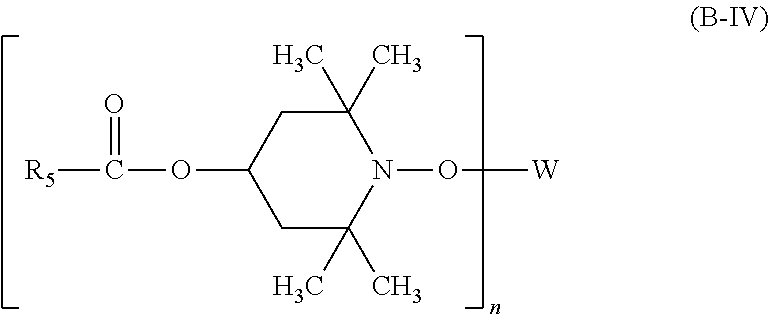




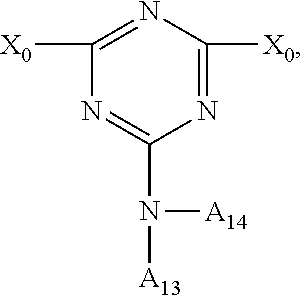






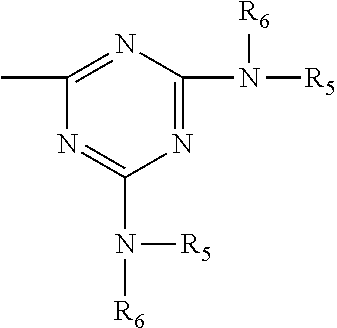


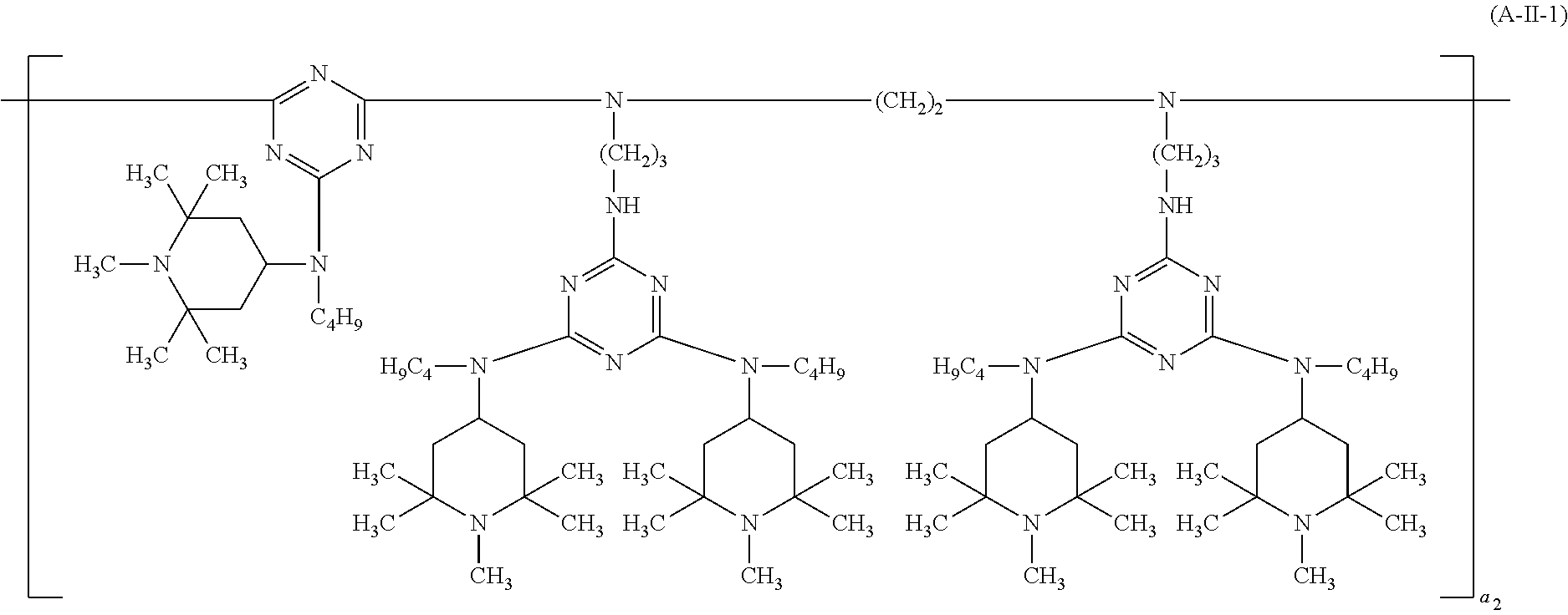





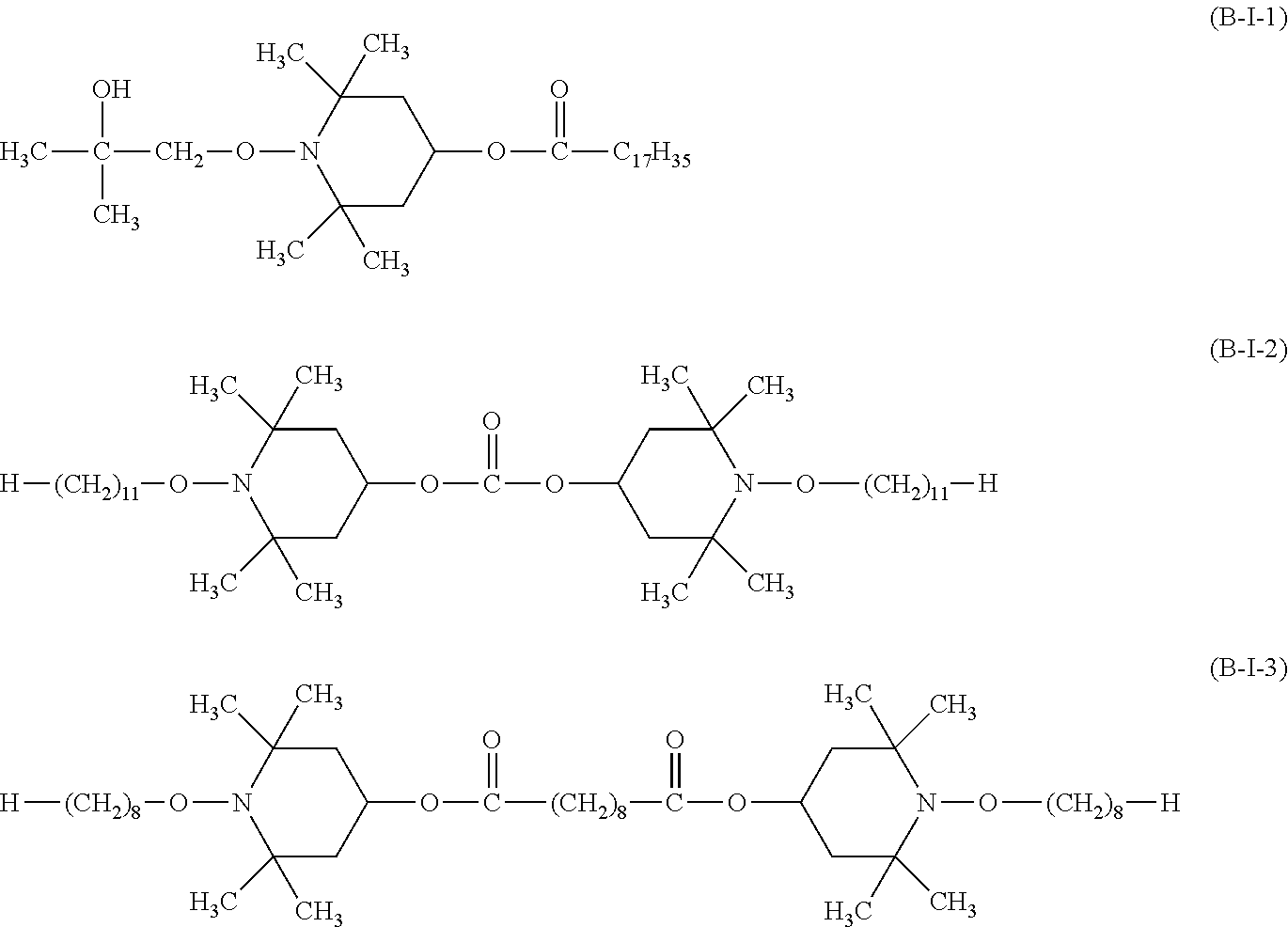





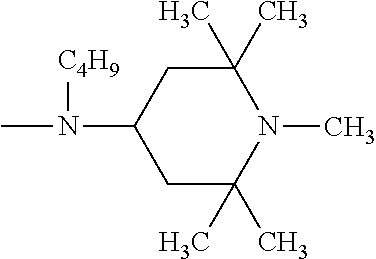
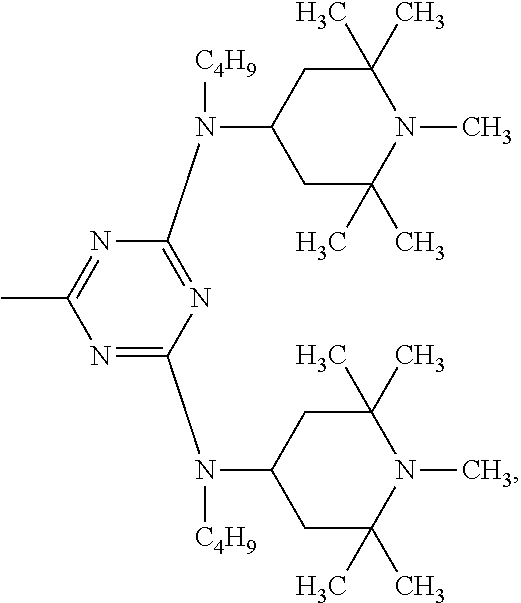

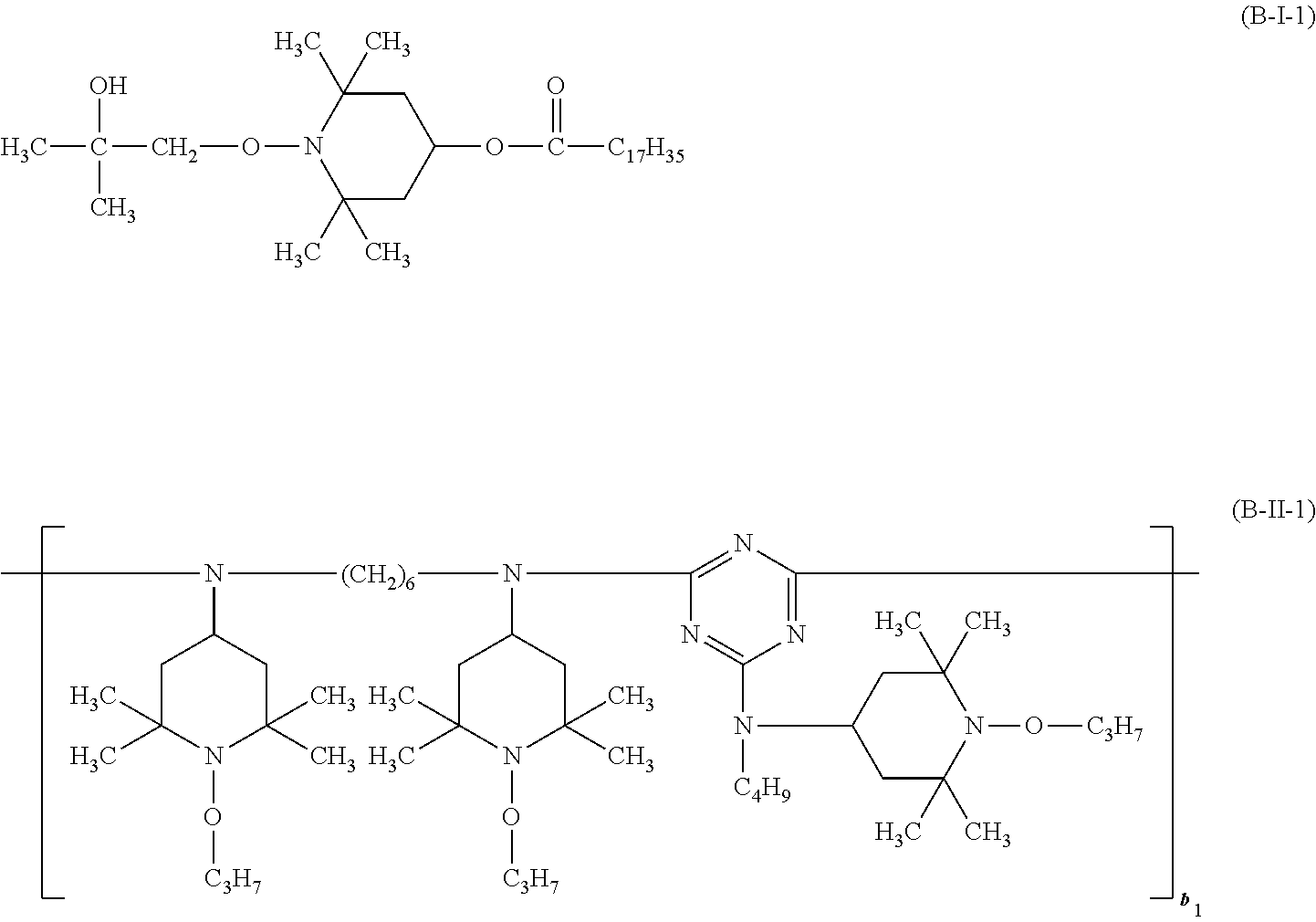

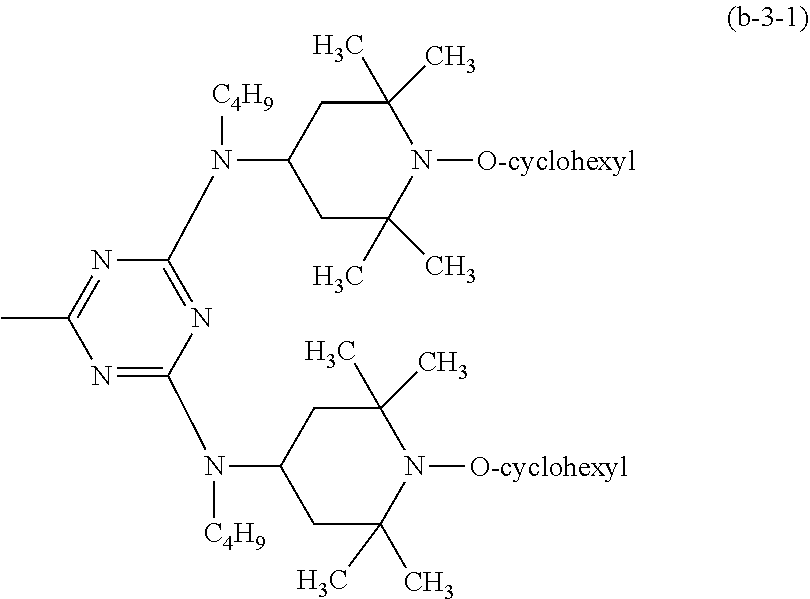


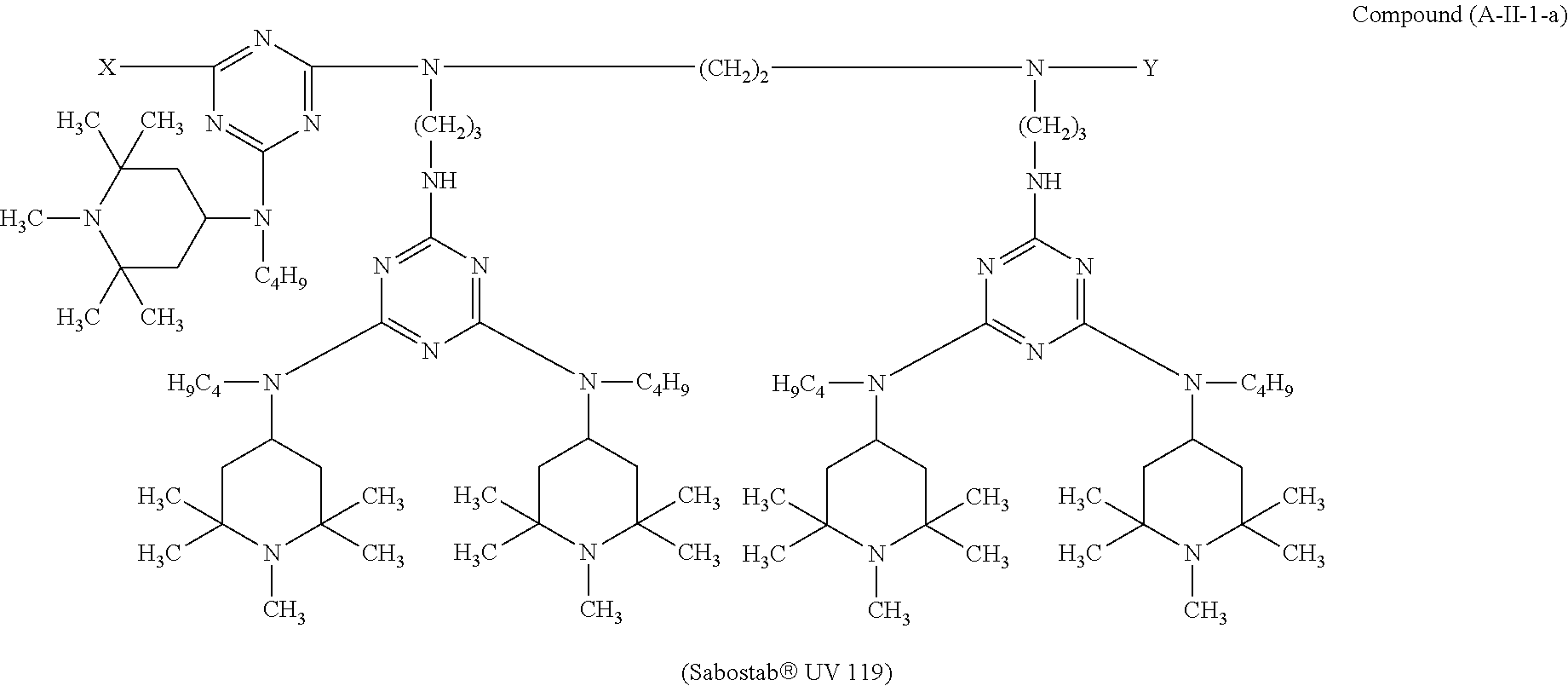






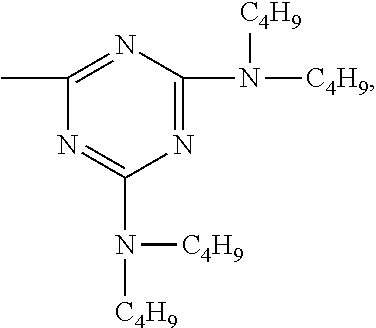


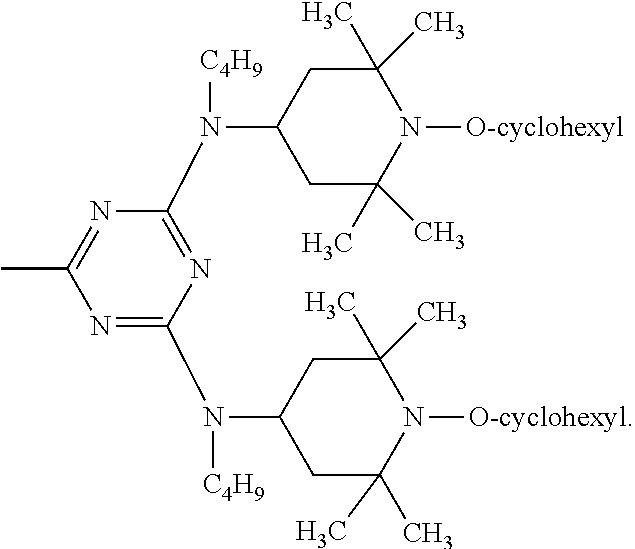





XML
uspto.report is an independent third-party trademark research tool that is not affiliated, endorsed, or sponsored by the United States Patent and Trademark Office (USPTO) or any other governmental organization. The information provided by uspto.report is based on publicly available data at the time of writing and is intended for informational purposes only.
While we strive to provide accurate and up-to-date information, we do not guarantee the accuracy, completeness, reliability, or suitability of the information displayed on this site. The use of this site is at your own risk. Any reliance you place on such information is therefore strictly at your own risk.
All official trademark data, including owner information, should be verified by visiting the official USPTO website at www.uspto.gov. This site is not intended to replace professional legal advice and should not be used as a substitute for consulting with a legal professional who is knowledgeable about trademark law.